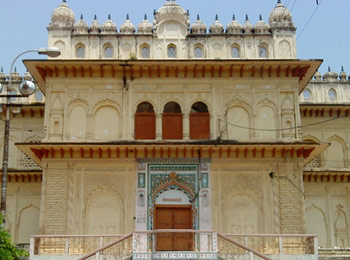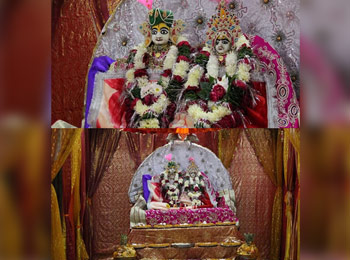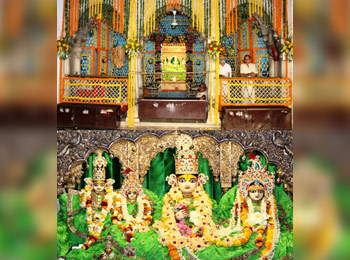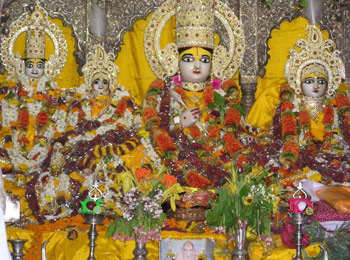- Vishnu
Kanak Bhavan
- Ayodhya,Uttar Pradesh
- View on map
- Tell us about this temple
Overview
Famously known as 'Sone ka Mandir', Kanak Bhawan is one of the very famous temples in India. The temple got its name due to the richely decorated idols of Lord Rama and Goddess Sita. The deities are seen wearing gold crowns and are decorated beautifully with gold jewelleries. It is mesmerising as well as a blessing to see the divine duo in the golden throne bedecked with gold ornaments.
According to Atharva Veda, Ayodhya is said to be "a city built by gods and being as prosperous as paradise itself." Popularly called Kanak Sone ki Mandir, the Kanak Bhawan Mandir, Ayodhya gets its name from the richly ornamented idols of Lord Rama and Goddess Sita. Kanak in Hindi means gold. The idols of Rama and Sita have been decorated with a large amount of gold ornaments. It looks gorgeous to see the duo in the golden throne bedecked with gold ornaments.
About The Temple

The ‘Kanak Bhawan’ is the biggest, religiously one of the most important architecturally and aesthetically built temple dedicated to Lord Ram and his divine consort Sita. It is located in the pilgrim holy town of Ayodhya in the state of Uttar Pradesh of India. This shrine is a marvelous sample of temple architecture and design, and is the most beautiful and attractive structure in Ayodhya. Its magnificence and charm is not only restricted to its external facade, but the deities installed in the sanctum are so beautiful and captivating to behold that one is left dumbfounded and spell-bound once one sees them. The enchantment of the divine view of the consecrated deities and their magnetic pull is of such intensity that the eyes of the beholder are riveted by their beauty, and he finds it difficult to move his eyes away from them. It is something to be experienced and not simply told and read, because the words have their own limitations, and something that has an ethereal and divine dimension cannot be put in shackles by the limitations of words. It becomes a sort of love at first sight when the visitor is compelled in his heart to make a promise to himself that he would come over and over again to experience and soak in this divine glory of the Lord as much as he can.
When the rays of the rising sun as well as that of the setting sun fall on the building, it looks fabulous, it presents a view that is exceptionally captivating and enchanting. The view of the face of the main structure of the temple that faces the sun, i.e. the wall of the main shrine that faces eastward towards the rising sun as seen from the inner courtyard, simply looks wonderful and out of the world as the first rays of the morning sun sprays it with its light. The same thing is experienced during the afternoon hours when the rays of the setting sun light up the walls of the building facing westwards as seen from the same inner courtyard. It’s a paradise of sorts for photo opportunity.
Conceived more as a sprawling palace rather than as a shrine, the Kanak Bhavan Temple resembles magnificent palaces of Bundelkhand and Rajasthan region of India. Its history dates back to Treta Yug when it was gifted by Ram’s step-mother Kaikeyi to him and his consort Sita as a marriage gift. With the passage of time it fell to ruin, and was reconstructed and renovated many times. The first reconstruction was done by Ram’s son Kusha in the beginning of Dwapar Yug, again by King Rishabdeo in middle of Dwapar, and Lord Krishna is said to have visited the ancient site in pre-Kali Yug era 614.
In the current Yug called the ‘Kali Yug’, it was first built by Chandra Gupta Vikramaditya in Yudisthir era 2431, repaired and renovated by Samudra Gupta in 387 A.D. (V.S. 444), destroyed by Nawab S. Salarjung II Gazi in 1027 A.D. (V.S. 1084) and then finally reconstructed on the ruins and renovated in the present shape by H.H. Maharaja Sri Pratap Singh Ju Deo, G.C.S.I., G.C.I.E. of Orchha and Tikamgarh (Bundelkhand) and his Queen Maharani Vrisbhan Kunwari, and consecrated in 1891 A.D. (V.S. 1948) Vaishkh Shukl 6th, Guru Pushya (roughly the month of May).
About The deity

There are three pairs of consecrated idols—and all of them are those of Lord Ram and Sita. The largest pair is the one installed by Rani Sri Vrishbhan Kunwari who was the moving force in the construction and establishment of this temple. The pair to its right is of a medium height and is said to be those which were established by King Vikramaaditya and were salvaged from destruction when that ancient temple was destroyed by invaders. The third pair is the smallest and is traditionally believed be the one that was given by Lord Krishna to a woman hermit who was meditating on Lord Ram at this site. Krishna instructed her to bury the idols in the ground when she leaves her mortal coil (body) so that later on they would be discovered and act as a mark to identify the sacred place when a king (who later turned out to be King Vikramaaditya) would set out to resurrect this holy place during Kali Yug. It so happened by providence that when Vikramaaditya was digging the foundation of his temple, this ancient pair emerged, and this helped this great king of India to locate the exact spot to establish the sanctum of his own grand temple.
When the current temple was built, all these three pairs were installed in its sanctum sanctorum. All the three pairs are seen now. Due obeisance and worship are offered regularly to all of them daily in the temple. Located at such a point from where the sunset and sunrise can be seen it is easily accessible by means of a rickshaw or a car from any point of Ayodhya. It is situated in Hanuman Garhi, a place frequented by tourists all-round the year. Referred to as Sone ke Ghar, this place draws more people because of the temple and the beautiful idols that are housed within it. The temple underwent restoration for a sufficiently large number of times.
Legend and Stories

Kanak Bhawan was gifted by Kaikeyee to Goddess Sita after her marriage to Lord Rama. Kaikeyee was the step-mother of Lord Rama and was responsible for their exile to the forest. And according to a variety of sources, Rani Krishnabhanu Kunwari, the Queen of Tikamgarh, constructed the present temple in 1891. The main temple is constructed around an open court in which stands the small shrine of Rampada. The sanctum is decorated very beautifully. The temple is of special attraction for the people of India and as well as for foreigners. The temple is located on a beautiful sight from where you can spot the mesmerizing sunrise in the morning and the thrilling sunset in the evening. The Kanak Bhavan Temple is integrally connected to the Indian Mythology. It is said that Kaikeyee, who was responsible for exiling Lord Rama and his wife Sita later built this temple for Sita as a mark of repentance.
This is according to popular legend, more authentic historical information say that Rani Krishnabhanu Kunwari of Orccha constructed this temple in 1891. Kanak Bhawanin Ayodhya is the palace of Sri Sita and Rama. It was a welcome gift to Sita from her mother-in-law Kaikeyi. Kanak Bhawan still exists in Ayodhya. It has a tradition of Sringar Bhakti. The divine couple is handled with love along with respect. Varied expression of this love for the divine is an intrinsic part of sadhna here. Raga, Sringar and Bhog seva holds good here. Rama, an incarnation of Lord Vishnu came with a mission to establish law and order, is generally treated with high regard, while Krishna came to love and be loved and is popular as an lovable, approachable personal friend. At Kanak Bhawan, the worship of Sita Ram is akin to that of Sri Radha Krishna in Vrindavan. Madhurabhakti is evident in festive celebrations, songs and the bhaav of pleasing the divine. Phool Banglas are an offering of love to please the divine couple, and shield them from the North Indian summer heat
Festivals
Though ceremonies and festivals keep on going throughout the year on various auspicious occasions according to the Hindu calendar, but some of them are special. All these occasions are marked by festivities and ceremonies as well as pomp and pageantry. Music and devotional songs reverberate in the temple. These special occasions are the following:
Ram Navmi
‘Ram Navmi’ marking the birth day of Lord Ram. It falls in the Hindu month of Chaitra which is roughly late March and early April.
Janki Navmi
‘Janki Navmi’ marking the birth day of Sita. It falls exactly one month after Ram Navmi, i.e. in late April or early May.
Phool Bangla
This is an occasion when the deity and the temple are decorated with flowers. It presents a fabulous sight.
Jhula or the Swing Festival
It is organized during the onset of the rainy season roughly in August. A silver Swing is installed in the main hall of the temple and the deity is brought out from the sanctum to enjoy the Swing. The festival lasts for about fifteen days continuously. On the first day of this festival, the third pair of deities is taken out in a procession in the evening from the temple compound, winds its way through the streets of Ayodhya to reach a place called Mani Parvat. It is a place where the deities of all other temples of Ayodhya too assemble. After return to the temple premises, Darshan (viewing) of the deity is held on the silver Swing already installed in the hall.
Vijaya Dashmi
This is the Dusshera festival just prior to the well-known Indian cultural extravaganza and the festival of lights known as Diwali/Dipawali. It marks the victory of Lord Ram over the demon king Ravana. A special Darshan (view of the deity) is held in the outer hall of the temple.
Sharad Purnima
This is the full moon night of Fall when it is believed that the Gods rain nectar on the earth from the heavens. On this occasion, a special Darshan (view of the deity) is organized in the open inner courtyard of the temple, directly under the beautiful light of the full moon shining overhead in the sky.
Sita-Ram Vivaaha
This celebration marks the marriage of the divine couple Lord Ram and Sita. It is done in the traditional method when all the steps of the actual marriage ceremony are performed. A marriage procession is taken out in the evening from the temple premises, goes round the town, and comes back. The actual marriage rituals are done during the late evening hours on a stage erected in the main hall of the temple. Thousand witness this ceremony personally. This festival falls in late November or early December.
Gauna
This is the time when the wife leaved her parental home for the home of her in-laws and husband. It is celebrated about a fortnight from the marriage festival.
Holi
This is the fabled festival of colours in India. A Darshan of the deity is organized in the main hall of the temple, and devotees offer dry coloured powder to their Lord.
Donations / Contributions
Devotees are welcome to donate or contribute or make charity to the temple fund according to your free will. All remittances should be made in the name of ‘Sri Brishbhan Dharm Setu Pvt. Trust’ by Cheque or bank Demand Draft payable at any bank in Ayodhya (Faizabad-UP).
It must be sent by registered post or courier to the following address - The Manager, Sri Brishbhan Dharm Setu Pvt. Trust, Kanak Bhavan Temple, Ram Kot, P.O. - Ayodhya, Pin - 224123, Distt - Faizabad, U.P., India.
If devotees wish to donate or contribute by cash, then there is a counter in the main hall of the temple where they are welcomed to do so. Please take a receipt for your donation.If followers wish to send by Money Order through the post office, then the address is the same as that for the cheque or the demand draft.
Aarti and Temple Timings
Open on all days of the year.
During Summer
- Morning - 8:00 am to 11:30 am, Evening - 4:30 pm to 9:30 pm.
- Aarti Timings - 8:00 am, 11:30 am, 7:00 pm, 9:30 pm.
During Winter
- Morning - 9:00 am to 12:00 pm, Evening - 4:00 pm to 9:00 pm
- Aarti Timings - 8:30 am, 12:00 pm, 6:30 pm, 9:00 pm.
Accessibility
How to reach Delhi
Airport
All the major National and International Air Lines have their flights operating from Delhi's Indira Gandhi International Airport.
Railways
The Indian Railways connects Delhi to all major and other destinations in India. There are three important Railway Stations in Delhi namely New Delhi Rly. Station, Old Delhi Rly. Station and Hazarat Nizamuddin Rly. Station.
Road
Delhi is well connected by road to all major destinations in North India. The Inter State Bus Terminus (ISBT) is located at Kashmiri Gate, Sarai Kale-Khan and Anand Vihar. Transport Corporations of the neighboring states provide frequent bus services through Air Conditioned, Deluxe and Ordinary Coaches.
Delhi to Sri Ram Mandir
Prepaid Taxi and Auto servies available from airport (both Domestic and International), all Railway Stations and Bus terminals and other important places.From New Delhi Railway station to Sri Ram Mandir, 20 Min by Auto Rickshaw.From Nizamudin Railway Station to Sri Ram Mandir,10 Min by Auto Rickshaw.From IGI and PALAM Airport to Sri Ram Mandir,45 Min by Auto Rickshaw.
Temple Address
Kanak Bhavan Temple,
Ram Kot,Ayodhya (p.o.),Faizabad Dist,
Uttar Pradesh, India, Pin-224123.
Significance
Devotees visit this temple to seek fulfillment of the following:-
- Fame
- Freedom from diseases
- Wealth
- Courage
- Relief from adverse effects from bad planetary aspects
- Relief from bondage
Shlokas
Achutham Keyshavam Rama Narayanam Krishna Damodaram Vasudevam Harim Shridharam Madhavam Gopika Vallabham Janaki Nayakam Ramachandram Bhajey
Meaning -Oh Lord who cannot be perished, who also has names like Keshava, Rama, Damodara, Narayana, Sridhara, Madhava, Krishna, Ramachandra the beloved of Janaki, let me say your name regularly.
Vasudeva Sutham Devam Kamsa Chanoora Mardhanam Devaki Paramanandham Krishnam Vande Jagathgurum
Meaning -I bow to you O Krishna, the ultimate guru, Devaki and Vasudeva's son, and the destroyer of Kamsa and Chanur.
Adharam Madhuram Vadanam Madhuram Nayanam Madhuram Hasitam Madhuram Hridayam Madhuram Gamanam Madhuram Mathuraa Dhipate Rakhilam Madhuram
Meaning -Meaning - Sweet are Your lips, sweet is Your face, sweet are Your eyes, sweet is Your smile, sweet is Your heart, sweet is Your gait, O Lord of Mathura, everything about You is sweet.
Alokya Mathur Mukha Madarena Sthanyam Pibantham Saraseeruhaksham Sachinmayam Devam Anantha Roopam Balam Mukundam Manasa Smarami
Meaning -I think of this Balamukundan as the one who looks lovingly at his mother's face while taking milk from her, who has eyes similar to the red lotus, who is the embodiment of truth and intelligence and other forms.
Timings
8:00 am to 12:00 pm and 4:00 pm to 9:30 pm
